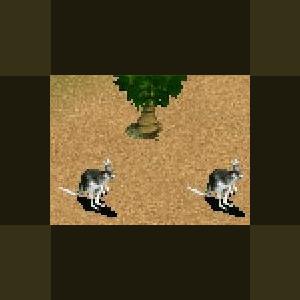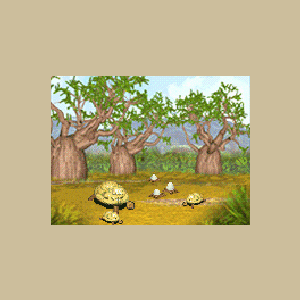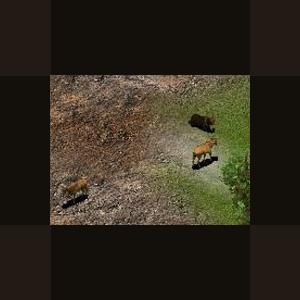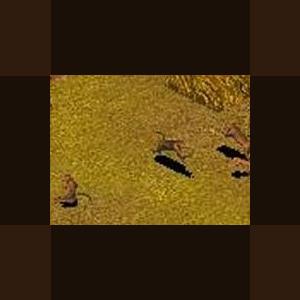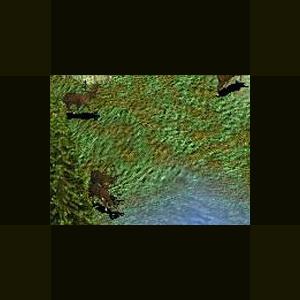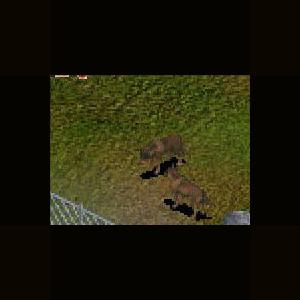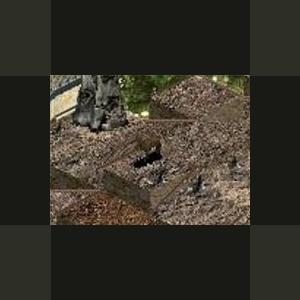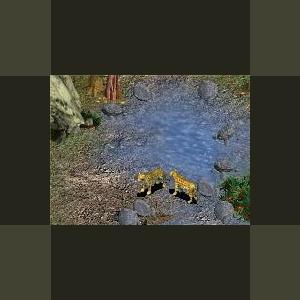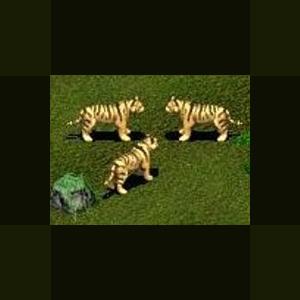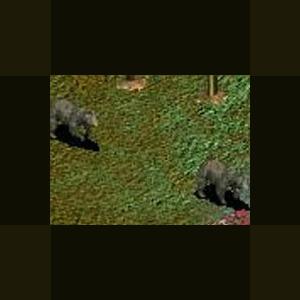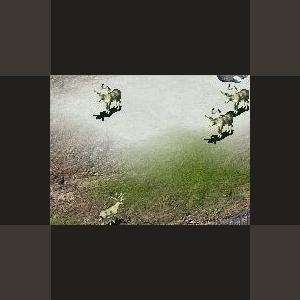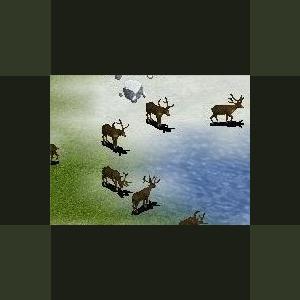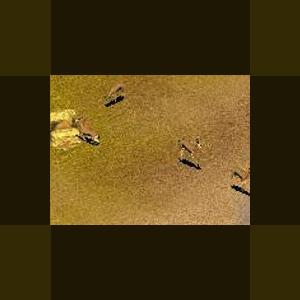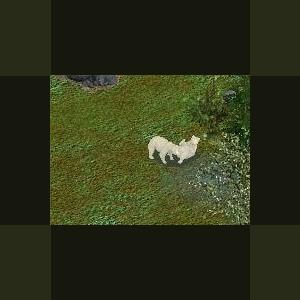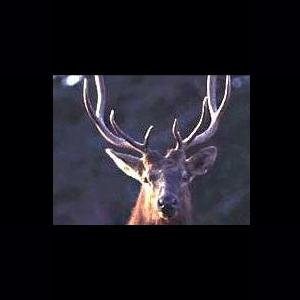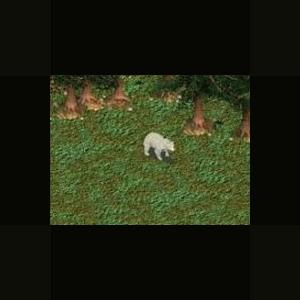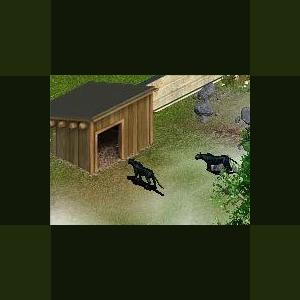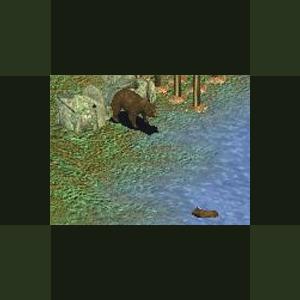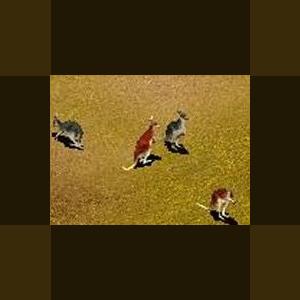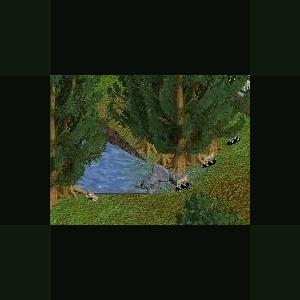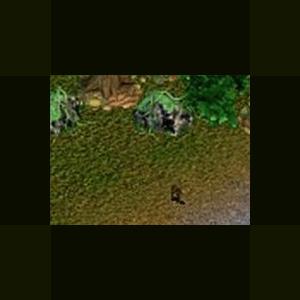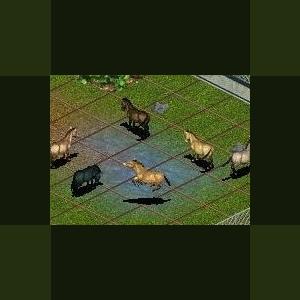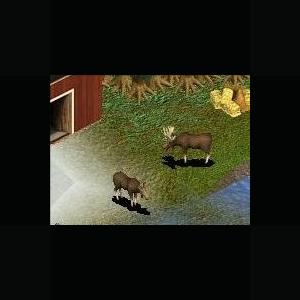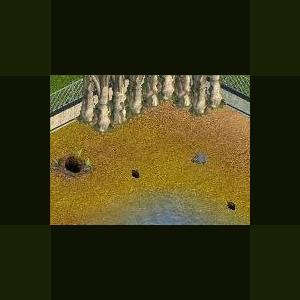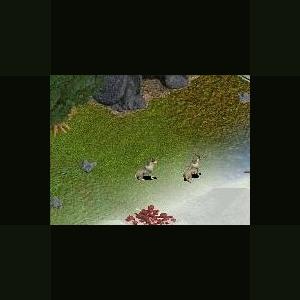279 files
-
White Boomer by IcePengwyn
By Guest
White Boomer
Author: IcePengwyn
This is a Boomer - an Old-Man White Kangaroo that pulls Santa in Australia. Stats have been changed from the red roo.
The Boomer is mostly savannah, but also likes a little snow, sandy beaches, and some tropical terrain as they have to cover all of Australia. They like all Aussie plants, as well as palm trees, the Christmas Tree and the Snowman
In Australia, Santa Claus uses Boomers or Old-Man Kangaroos to pull his sleigh, as it is too warm for the Reindeer. Boomers like the Christmas Tree, Snowman, Palms, and a little snow for a Aussie White Christmas. The Boomers are quite tolerant of different habitats, as they are very laid back, man.
Updated 2010-11-11
Just to save space with less in zip and smaller image.
Nothing new.
225 downloads
0 comments
Updated
-
Galapagos Tortoise ZTU Belgium
By Guest
The Galàpagos tortoise, or commonly known as the Giant tortoise: Two huge endangered species of tortoise found on the Aldabra Atoll in the Indian Ocean and on the Galápagos Islands off the coast of Ecuador in the Pacific. Both the Aldabran tortoise and the Galápagos tortoise, the latter made famous by Charles Darwin, can reach lengths in excess of 1 m (3½ ft) and weigh over 250 kg (551 lb). Reptiles of this size are likely to be very old, as growth is very slow; records exist of tortoises reaching 150 years of age.
The tortoise is now rare because of human slaughter of the animals, the destruction of its habitat, and the introduction of animals that feed on the young tortoises and compete for food with the adults. During the 19th century in particular, giant tortoises were heavily hunted by sailors, as a source of fresh meat, both while visiting islands and to take away on long voyages. The tortoises have been known to survive as long as 14 months without food or water. In the Galápagos the giant tortoises have evolved different shell, or carapace, shapes on the various islands.
This is a result of variations in habitat and the plants they eat. On those islands with limited food resources, smaller tortoises have evolved.
They have shells elevated above the neck and long legs which allow them to reach slightly higher vegetation. Two island forms are known to be extinct and a third is reduced to a single animal, "Lonesome George", the only remaining tortoise from Isla Pinta, who now resides at the Charles Darwin Research Station. Hope for the survival of giant tortoises relies upon continued worldwide protection and the success of the captive breeding programme instigated over 20 years ago at the Darwin station. Female tortoises lay up to 17 eggs in a 30-cm (12-in) hole and the young dig out on their own. Many captive-born tortoises have already been returned to the wild.
This was a unicum for ZTU. The first* animal from scratch, created by ZTU designer Jonathan is available here for download! This turtle will look great and your zoos although it has a little bug, it lays baby flamingo's instead of the baby turtles, I'm working on it now. Please bare with us.
Updated 2010-11-03
Just to save space with less in zip and smaller image.
Nothing new
520 downloads
Updated
-
European Mouflon by Ghirin
By Guest
The European mouflon (Ovis ammon musimon, Ovis musimon) is the smallest and westernmost of the wild sheep and is thought to be one of the ancestors of the domestic sheep (along with the Asiatic mouflon). The European mouflon once lived in most of the mountain ranges of Europe, but hunting and agriculture have markedly reduced mouflon numbers. Remnant herds still exist on the islands of Corsica and Sardinia, and the mouflon has been reintroduced to areas of its former range.
Mouflon prefer to live in lightly wooded areas located on the middle slopes of mountains. They are most active in the morning and late afternoon.
References:
http://animaldiversity.ummz.umich.edu/accounts/ovis/o._ammon_musimon$narrative.html
http://www.ansi.okstate.edu/breeds/sheep/
Walker's Mammals of the World. Nowak, 1999.
Created by Ghirin 2003
Updated 2010-11-03
Just to save space with less in zip and smaller image.
Nothing new
348 downloads
0 comments
Updated
-
Patas Monkey by Ghirin
By Guest
Patas monkeys (Erythrocebus patas) live in the open savannah country of western Africa. They have distictive reddish fur and spend most of their time on the ground. These monkeys have long limbs and are fast runners.
*Inspired by the Zoo Tycoon Brains Trust at the Zoo Tek Forums
Reference:
Bonadio, C. 2000. "Erythrocebus patas" (On-line), Animal Diversity Web. Accessed February 20, 2005 at http://animaldiversity.ummz.umich.edu/site/accounts/information/Erythrocebus_patas.html.
Created by Ghirin 2005
Updated 2010-11-05
Just to save space with less in zip and smaller image.
Nothing new.
297 downloads
0 comments
Updated
-
Woodland Caribou by Ghirin
By Guest
The woodland caribou (Rangifer tarandus caribou) is a distinct subspecies from the more numerous barren ground caribou. It lives in the boreal forests south of the tundra and is less likely to migrate over large distances. It is also darker in color than other subspecies of caribou.
Woodland caribou prefer mature coniferous forests as habitat. This type of forest produces adequate amounts of ground and tree lichen that the caribou depend upon for food. The ratio of lichen in the diet varies with the time of year: up to 70% of the winter diet may be composed of lichens while the summer diet may only be 25-30% lichen. The balance of the diet is composed of grasses and shrubs.
Created by Ghirin 2003
Updated 2010-11-11
Just to save space with less in zip and smaller image.
Nothing new.
382 downloads
0 comments
Updated
-
Small-eared Dog by BigCatKeeper
By Guest
Small-eared Dog
Author: BigCatKeeper
Also known as the Small-Eared Fox, Small-Eared Zorro, Short-Eared Fox, and Dusicyon Microtis.
They have a thick, stocky body set on relatively short narrow legs. Their muzzle is very long and thin, with short, rounded ears set to the sides of the head. They range from dark reddish-grey to black on their backs, blending to a rufous color underneath. Their undersides have pale-colored parts. Their bushy tail has very thick, black hair.
Their paws are partially webbed, suggesting that they may be somewhat aquatic.
Average height is 10 in. (25 cm), weighing 22 lb (10 kg).
Small-Eared Dog can be either nocturnal or diurnal, and natives report that they are solitary. For the most part, they seem to be docile and non-aggressive towards humans. Males seem to have a musky odour that females do not.
The most urgent threat to this dog is habitat loss, since they only thrive in areas undisturbed by humans. Jaguars, ocelots and cougars are all potential predators of this much smaller fox.
Small Eared Dog created by Bigcatkeeper
Updated 2010-11-06
Just to save space with less in zip and smaller image.
Nothing new.
252 downloads
0 comments
Updated
-
Walia Ibex by Ghirin
By Guest
Walia Ibex
Author: Ghirin
http://www.zoo-tek.com/forums/index.php?download=80
The Walia ibex (Capra walie, Capra ibex walie) is the southernmost member of the ibex family. This population of wild goats is only found in the Simein Mountains in northern Ethiopia. Like other populations of ibex, the Walia ibex dwells in steep habitats.
*Inspired by the Zoo Tycoon Brains Trust at the Zoo Tek Forums
Created by Ghirin 2005
Updated 2010-11-11
Just to save space with less in zip and smaller image.
Nothing new.
217 downloads
0 comments
Updated
-
Arizona Jaguar by Ghirin
By Guest
Arizona Jaguar by Ghirin
The Arizona jaguar (Panthera onca arizonensis) was the northernmost subspecies of jaguar. It was also one of the largest subspecies. Unlike the most familiar tropical jaguars of Central and South America, the Arizona jaguar lived in the dry highlands of the southwestern United States.
The last sightings of the Arizona jaguar were in 1905. The subspecies has been officially declared extinct.
Reference:
The Doomsday Book of Animals. Day, 1981.
Created by Ghirin 2004
Updated 2010-10-30
Just to save space with less in zip and smaller image.
Nothing new.
541 downloads
0 comments
Updated
-
Sumatran Tiger by Moondawg
By Guest
Sumatran Tiger
The Sumatran tiger (Panthera tigris sumatrae) is a subspecies of tiger found on the Indonesian island of Sumatra. The wild population is estimated at between 400 and 500 animals, occurring predominantly in the island's national parks. Recent genetic testing has revealed the presence of unique genetic markers, indicating that it may develop into a separate species, if it is not made extinct. This has led to suggestions that the Sumatran tiger should have greater priority for conservation than any other subspecies. Habitat destruction is the main threat to the existing tiger population (logging continues even in the supposedly protected national parks), but 66 tigers were recorded as being shot and killed between 1998 and 2000—nearly 20% of the total population.
The Sumatran tiger is the smallest of all extant tiger subspecies. Male Sumatran tigers average 234 cm (7 feet, 8 inches) in length from head to tail and weigh about 136 kg (300 pounds). Females average 198 cm (6 feet, 6 inches) in length and weigh about 91 kg (200 pounds). Its stripes are narrower than other subspecies of tigers' stripes, and it has a more bearded and maned appearance, especially the males. Its small size makes it easier to move through dense rain forests. It has webbing between its toes that, when spread, makes Sumatran tigers very fast swimmers. It has been known to drive hoofed prey into the water, especially if the prey animal is a slow swimmer.
Sumatran Tigers commonly prey on larger ungulates, like wild boar, tapir and deer, and sometimes also smaller animals, like fowl, and fish. Orangutans could be prey, but since they spend a minimal amount of time on the ground, tigers rarely catch one.
Analysis of DNA is consistent with the hypothesis that the Sumatran tigers have been isolated after a rise in sea level at the Pleistocene to Holocene border about 12.000-6.000 years ago from other tiger populations. In agreement with this evolutionary history, the Sumatran tiger is genetically isolated from all living mainland tigers, which form a distinct group, closely related among each other.
The Sumatran tiger is only found naturally in Sumatra, a large island in western Indonesia. It lives anywhere from lowland forests to mountain forest and inhabits many unprotected areas. Only about 400 live in game reserves and national parks, The largest population of about 110 tigers lives in Gunung Leuser National Park. Another 100 live in unprotected areas that will soon be lost and the rest are spread out in areas that are quickly being lost to agriculture. The reserves are not safe because, despite conservation efforts, many tigers are killed by poachers each year.The Sumatran tiger is found only on the Indonesian island of Sumatra in habitat that ranges from lowland forest to sub mountain and mountain forest including some peat moss forests. According the the Tiger Information Center and the World Wildlife Fund there are no more than 500 of these tigers left in the wild with some estimates considerably lower.
The continuing loss of habitat is intensifying the crises to save this tiger.
In 2007, the Indonesian Forestry Ministry and Safari Park established cooperation with the Australia Zoo for the conservation of Sumatran tigers and other endangered species. The cooperation agreement was marked by the signing of a Letter of Intent on 'Sumatran tiger and other Endangered Species Conservation Program and the Establishment of a Sister Zo Relationship between Taman Safari and Australia Zoo' at the Indonesian Forestry Ministry office on July 31, 2007. The program includes conserving Sumatran tigers and other endangered species in the wild, efforts to reduce conflicts between tigers and humans, and rehabilitating Sumatran tigers and reintroducing them to their natural habitat.
Updated 2010-11-06
Just to save space with less in zip and smaller image.
Nothing new.
359 downloads
0 comments
Updated
-
Glacier Bear by Ghirin
By Guest
Glacier Bear
Author: Ghirin
The glacier bear is a rare color phase of the American black bear. Glacier bears are various shades of blue-gray and are found in southeastern Alaska, northwestern British Columbia and the southwestern Yukon Territory. The undercoat of glacier bears is blue-black and the outer guard hairs are white with silver tips. The blue-gray color serves as camouflage against a backdrop of frozen ice.
Glacier bears enjoy a mixture of coniferous and deciduous habitat with slight elevation. Don't confuse with Artic glacier bear.
Created by Ghirin 2003
Updated 2010-11-03
Just to save space with less in zip and smaller image.
Nothing new
253 downloads
0 comments
Updated
-
Peary Caribou by Ghirin
By Guest
The Peary caribou (Rangifer tarandus pearyi) is the northernmost subspecies of caribou. It lives on the islands of the Canadian Arctic Archipelago and is the smallest subspecies of living caribou. The Peary caribou's coat changes color with the season. In the winter, the coat is white to blend with the snowy habitat. The summer coat is slate gray with white underparts.
The habitat of the Peary caribou is treeless. In the summer, the caribou forage in moist areas such as the slopes of river valleys and upland plains for grasses, sedges, and willows. The caribou forage in higher areas in the winter where the snow is thinner and easier to dig through.
Created by Ghirin 2003
Updated 2010-11-05
Just to save space with less in zip and smaller image.
Nothing new.
380 downloads
0 comments
Updated
-
Barren Ground Caribou by Ghirin
By Guest
Barren-ground Caribou
Author: Ghirin
The barren-ground caribou (Rangifer tarandus granti and Rangifer tarandus groenlandicus) are one of the three varieties of North American caribou. (The other varieties are woodland and Peary.) The Alaskan subspecies (R. t. granti) lives west of the Mackenzie River, while the Canadian subspecies (R. t. groenlandicus) lives east of that river. The name "barren-ground" refers to the artic tundra that these animals live on.
Barren ground caribou are known for their tendency to form large, migrating herds. During the spring and summer months, barren-ground caribou migrate to their calving grounds in the high arctic. They then migrate to southern lands to avoid the harsh winter.
Like other caribou, barren-ground caribou are vegetarians, feeding on young leaves, lichens, grasses, and sedges. When the ground in covered with snow, they will scrape the snow aside with their hooves. This behavior has given the animals their name, derived from the Mi'kmaq term "xalibu" meaning "one who paws".
Created by Ghirin 2004
Updated 2010-10-30
Just to save space with less in zip and smaller image.
Nothing new.
532 downloads
0 comments
Updated
-
Red-fronted Gazelle by Ghirin
By Guest
Red-fronted Gazelle
Author: Ghirin
http://www.zoo-tek.com/forums/index.php?download=144
The red-fronted gazelle (Gazella rufifrons) inhabits the dry steppe region of the Sahel in north central Africa. These gazelles are more water dependent than other dry-land gazelles and thus follow the rains: north into the desert during the wet season and back to the southern end of their range during the dry season.
These gazelles prefer open habitat such as thornbush savanna and vegetation-covered dunes.
Created by Ghirin 2003
Updated 2010-11-05
Just to save space with less in zip and smaller image.
Nothing new.
276 downloads
0 comments
Updated
-
Kermode Bear by Ghirin
By Guest
Kermode Bear
The Kermode bear, also known as the spirit bear, is a rare color phase of the North American black bear. These bears are only found in the temperate coastal rainforests of British Columbia, with most of the population living on Princess Royal Island and Gribbell Island.
Only about one in ten of local bear population is actually the creamy white color of the Spirit bear. The others are the normal colors of the black bear (black, brown, grey, or cinnamon).
Created by Ghirin 2004
Updated 2010-11-03
Just to save space with less in zip and smaller image.
Nothing new.
245 downloads
Updated
-
Roosevelt Elk by Jordan
By Guest
Roosevelt Elk (Wapiti)
Scientific Name:
Cervus elaphus roosevelti
Size:
Height. at shoulder 4½-5'
Length. 8-10'
Weight. males 600-1000 lbs. | females 350-650 lbs.
Characteristics:
Adaptations/Coloration. brown or tan above | darker underparts | rump patch & tail yellowish brown | males dark brown mane on throat
Antlers. males large, many-tined antlers up to 5' | females lack antlers
Behavior:
crepuscular | during rut males rub antlers on saplings & shrubs | antlers used as weapons in fights for females | dig wallows in ground with hooves & antlers
reproduction/life span
Breeding Season. "rut" late Aug-early Oct
Gestation. ~8½ months | cows leave herd to give birth to 1 calf (twins rare)
Calf. 30-35 lbs. | cow & calf return to herd ~1 wk
Diet:
primarily grazers | many plants
habitat/range
coastal & Cascade ranges of Pacific Northwest | summer found in high open mountain meadows | winter lower wooded slopes, often dense woods
Created by JordanMK.
A BIG 'Thank you' to LAwebTek for letting me use his Whitetail Deer as a base for this project.
Updated 2010-11-05
Just to save space with less in zip and smaller image.
Nothing new.
524 downloads
0 comments
Updated
-
Chinese White Bear by Ghirin
By Guest
Chinese White Bear
Author: Ghirin
The Chinese White Bear is a legendary animal from the Hubei province of China. It is pure white and is said to live in the Shennongjia forests of that region. It might be a white phase population of Asian brown or black bears.
Created by Ghirin 2005
Updated 2010-10-30
Just to save space with less in zip and smaller image.
Nothing new.
Updated by JohnT with corrections and some clean up in deleting unneeded pal files and uca stuff!
New uca date Aug 20 2012
334 downloads
0 comments
Updated
-
Black Puma by LAwebTek
By Guest
Black Puma
Author: LAwebTek
Black (Melanistic) pumas, also known as cougar, panther, mountain lion, night screamer, catamount, mountain devil, and king cat, are not a separate subspecies of puma, but rather a color variation within the species. Black pumas are extremely rare to the extent that no one has ever captured one and placed it in captivity. There are very few photographs or sightings of the black puma, although clearly enough to prove that the animal does exist and is not a myth as was once believed.
Black pumas are believed to reside primarily in Canada and the northern most parts of the United States. The black color is an adaptation to the colder climate, while pumas in most of North and South America have a redish-brown color. The black puma's ideal habitat is mountainous forests up to 16,000 feet. Pumas are very territorial and mark their territory. They are carnivores that are active both day and night and their prey consists of a variety of mammals, birds and fish. If larger animals such as white-tail deer, caribou and moose are not available, the puma is able to adapt quickly and switch to smaller prey such as raccoon, skunk, birds and fish. If hungry enough, the puma will even take down horses, cows, and other livestock and so it has a bad reputation by farmers.
Black pumas can range in weight from about 150 lbs. to 200 lbs, the male is larger than the female. Their tail can be almost as long as their body length and is used for balance. Using sight and sound more then scent, the puma stalks its prey. Their back legs are more developed than their front legs which allows them to ambush prey and jump on their backs to go in for the kill. Pumas have the ability to leap an incredible 40 feet. The strong muscle development in the back also enables the puma to maneuver in the more difficult mountainous areas and steep ravines. When hunting, the puma grips into the victims neck and either snaps the prey's neck or grips into the windpipe until it suffocates. After the puma kills its victim, it will cover it with debris to reduce the risk of other animals finding the carcass and to prolong the food.
Males breed with a large number of females to increase reproductive success. One male will have a very large range and all the females, who have much smaller ranges are resident in the male's territory, will mate with that one male. The male will search for days for the female(s), covering 50 km in a day and night. The puma, who hunts silently, will howl when ready to breed. Pumas do not choose a particular season to mate. The females will mate starting around age two or three and will select a cave or other shelter as a spot for her cubs' birth. One to six cubs may be born, blind and helpless. They gain vision after two weeks. The cubs will grow its parents' muscular jaws, wide gape, and long teeth which are designed to clamp into it's prey, as well as to eat it. While they are cubs, the female will protect and feed them. This will continue until they are about a year and a half old and can defend themselves.
Updated 2010-10-30
Just to save space with less in zip and smaller image.
415 downloads
0 comments
Updated
-
Kodiak Bear by Ghirin
By Guest
Kodiak Bear
The Kodiak bear (Ursus arctos middendorffi) is the largest subspecies of brown bear and the second largest carnivore in the world (second only to the polar bear). Mature boars (males) can reach 1500 pounds in weight, while mature females can reach up to 750 pounds. Male shoulder heights have been recorded up to 5 feet with standing heights up to 10 feet.
This unique bear is native only to the islands the Kodiak Archipelago, including Kodiak, Shuyak, and Afognak, and have been isolated from other brown bears for about 12,000 years. The current population is between 2800 to 3000 bears.
Even though they are classified as carnivores, Kodiak bears are actually omnivorous, eating a variety of foods and concentrating on what foods are in season. They eat a number of plant foods such as grasses, sedges, and berries when the the plants are most nutritous. Eggs, nestlings and salmon are also valued as rich sources of nutrition and a source of fat for winter hibernation.
Created by Ghirin 2003
Updated 2010-11-03
Just to save space with less in zip and smaller image.
Nothing new.
448 downloads
0 comments
Updated
-
Dimorphic Red Kangaroo by Ghirin
By Guest
Dimorphic Red Kangaroo
Author: Ghirin
Red kangaroos are the world's largest marsupials. Despite the name, not all red kangaroos are red. In the eastern part of their range, males are usually some shade of red and females are blue-gray; elsewhere, both sexes may be reddish brown. Male kangaroos are called "boomers," female kangaroos are "blue fliers," and young are called "joeys." Red kangaroos are found primarily in the dry grasslands and plains of central Australia. The terrain in this region consists of savannah-like grasses interspersed with barren areas of dry dirt, sand, and the occasional rock. Kangaroos prefer open areas, with a sparse scattering of native bushes and trees for shade. Kangaroos are semi-nomadic, and their movements are not restricted by most types of fencing.
These animals congregate in loose and temporary social groupings, called mobs. Although the makeup of a mob can vary, it will commonly contain a dominant male, several adult females, and young of both sexes. Mothers and young can remain together for years.
Kangaroos are able to survive high temperatures by seeking shade during the day and feeding at night. In the wild, their diet consists of green grass, leaves, and roots. They swallow their food whole, later regurgitating a cud and chewing it. In the wild, this animal does not need continual access to fresh water, as long as green herbage is available. When necessary, they will dig for water. In zoos, kangaroos are fed a diet that typically includes fruit, yams, bread, monkey-dog-guinea pig chow, and vitamin supplements.
Baby kangaroos are bean-sized when born. The tiny, hairless embryo makes its way across the mother's belly into the pouch, where it attaches itself to one of the four available teats. Once nursing begins, the teat swells up so that the baby will remain attached. The joey will remain in the pouch for 5 to 6 months as it continues to mature. After that, it will be fully developed and can emerge to explore. Joeys are usually weaned around one year of age, but will remain close to the mother for another six months.
Kangaroos are so well-designed for hopping that they are unable to walk. They have large, powerful hind feet that cannot move independently of each other and a tendon in their legs that behaves like a rubber band, conserving energy as they move. Red kangaroos can hop as fast as 40 mph, making leaps as long as 29 feet. Kangaroos will run from danger, rather than fight, although a large claw attached to their hind leg makes them quite dangerous at close quarters. The kangaroo's long, heavy tail provides balance and support.
Red kangaroos are shy, alert creatures, docile except when cornered. To warn their mob of impending danger, these animals will thump on the ground. Hearing this warning, joeys will jump back into their mothers' pouches. Although males will not defend the members of their mob from attack, they will fight each other for breeding rights. The two boomers will attempt to push each other off balance by jabbing or locking forearms. Sometimes they will lean back on their tails and kick each other in the belly with their powerful hind feet.
Foxes and eagles prey on very young kangaroos. Dingoes prey on young and adult alike. Because of the damage they can do to crops, kangaroos are considered pests and are destroyed accordingly. Red kangaroos are also commercially hunted for skins and meat. This animal is considered a threatened species.
Updated 2010-10-30
Just to save space with less in zip and smaller image.
Nothing new.
341 downloads
Updated
-
Japanese Wolf by Ghirin
By Guest
Japanese Wolf
Author: Ghirin
A correction and update for the original Japanese wolf which was released Aug 8 2003
The Japanese wolf (Canis lupus hodophilax), was the smallest species of gray wolf in the world (about the size of a jackal). It was found on the Japanese islands of Honshu, Hokkaido, Shikoku and Kyushu where it lived in the mountainous areas. Its small stature and short legs were ideal for roaming the mountain forests.
The Japanese wolf was known by several names including shamanu, okami (Great God), magami (True God), and yama no kami (Mountain God). The Ainu people of Japan called it the Howling God because these wolves would howl for hours from hilltops and mountains.
Even though this wolf was small, many legends surrounded it. Many people feared the Howling God and placed charms near their doors to ward it away. Others thought of the wolf as a protector and built shrines to it.
As the human population of Japan increased, the Japanese wolf lost habitat. A bounty was also paid for its skin. The last recorded killing of a wolf was in 1905, though some have reported sightings of an animal resembling the Japanese wolf.
It's interesting that there is Japanese serow in the new animal pack. The wolf and serow would make nice complimentary exhibits in a Japanese-themed area. The Japanese wolf is also very attractive to guests.
Created by Ghirin 2003
Updated 2010-11-03
Just to save space with less in zip and smaller image.
Nothing new.
340 downloads
0 comments
Updated
-
Water Chevrotain by Ghirin
By Guest
Water Chevrotain
Author: Ghirin
The water chevrotain (Hyemoschus aquaticus) is the largest species of chevrotain and is native to the African rainforest. It is the size of a large rabbit, has an arched back, a raised rump, and a stocky body on slender legs. Neither sex has antlers, but the males have sharp tusks that extend below the upper lips. They have short, brown fur with pale spots and stripes on the head and neck to serve as camouflage. The head is pointed with large eyes, slit-like nostrils, and medium-sized ears.
Water chevrotains are true ruminants and are considered to be living links between the deer and the pigs. They feed mainly on fruits, leaves and buds, with occasional animal matter.
These animals are usually solitary. Females occupy a limited home range while the range of males usually overlaps the range of two females. While females stay within their home ranges for life, males are regularly expelled from their home ranged by other males.
Water chevrotains are active only at night, with females being more active than males. During the day, they rest under thick vegetation. At night, these animals come to river banks and clearings to forage. They may retreat to water as means of escape, but they do not remain in water for prolonged periods of time
Created by Ghirin 2004
Updated 2010-11-11
Just to save space with less in zip and smaller image.
Nothing new.
257 downloads
0 comments
Updated
-
Horse Pack by Jordan
By Guest
Horse Pack by Jordan
Six colors of horses that will live happily together. Includes: bay, black, buckskin, palomino, sorrel and roan horses.
Updated September 8, 2023 by Jay to show the preferred foliage tooltip for the female and young, to correct the behaviors broken by APE, to remove unnecessary files and configuration lines, to add some spacing in the animal info, and to include a combined ztd.
Updated 2010-11-03
Just to save space with less in zip and smaller image.
Nothing new
640 downloads
Updated
-
Nordic Moose by Jordan
By Guest
Nordic Moose by Jordan
Made by Jordan and dedicated to Jane.
Updated 2010-11-04
Just to save space with less in zip and smaller image.
Nothing new.
245 downloads
Updated
-
Spotted Tailed Quoll by Jordan
By Guest
A small marsupial.
Updated 2010-11-06
Just to save space with less in zip and smaller image.
Nothing new.
233 downloads
0 comments
Updated
-
Nordic Gray Wolf by Jordan
By Guest
Nordic Gray Wolf by Jordan
Made by Jordan and dedicated to Jane.
Updated 2010-11-04
Just to save space with less in zip and smaller image.
Nothing new.
303 downloads
Updated

